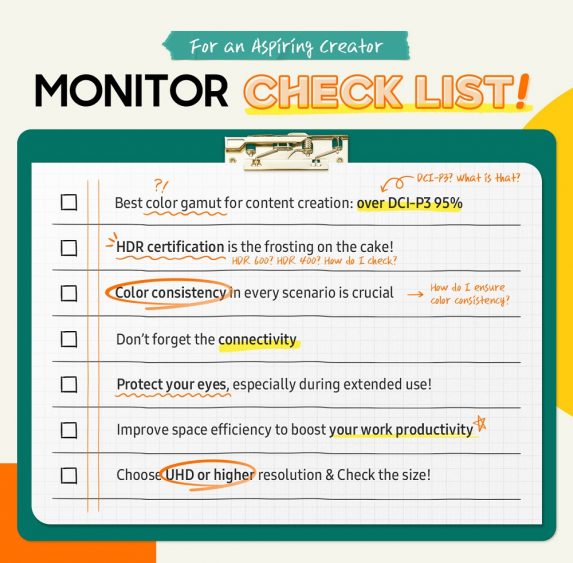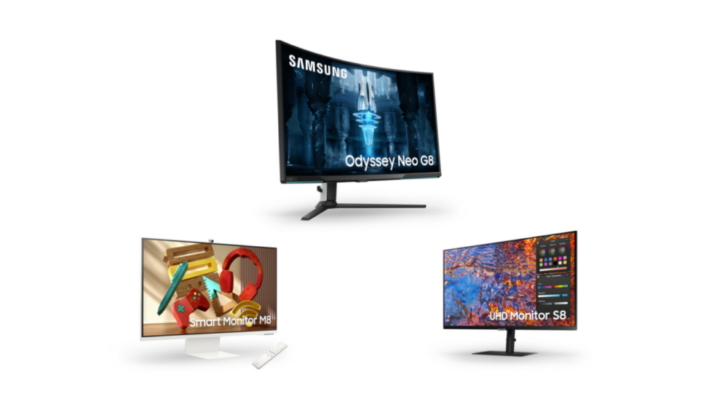[ViewFinity S8] Your Guide to Selecting the Ultimate Content Creation Monitor
on June 23, 2022

With the ever-growing popularity and accessibility of social video platforms, today, anyone can become a creator. To grow their platforms, new creators are choosing professional-grade editing programs and hardware to produce exciting content and increase subscribers. As a result, the demand for high-quality monitors is skyrocketing.
According to Markets & Research, the global Professional Monitors market size was estimated to be worth $1048.6 million in 2021 and is forecasted to be $1492.1 million by 2028.
If you’re looking to break into content creation, use the following checklist when picking your next monitor.
# Want To Be a Content Creator? Here Is How To Pick The Perfect Monitor

# Not Familiar With The Terminology Yet? This Guide Will Help You
Looking to choose a new monitor for content creation? Don’t let unfamiliar jargon put you off. Let’s take a deep dive into the world of monitors.
1. DCI-P3: Reproducing accurate colors from shot to screen

DCI-P3, the triangle highlighted on the colorful diagram, constitutes a range of colors that can be presented on a given display, such as a monitor. Simply put, they use figures to indicate the extent of a display’s color handling capabilities. This is why it is called a color gamut, because gamut means a full scope or range of something.
Color standards vary by institutes depending on the purpose and criteria of the color gamut. Classic examples include DCI-P3, sRGB and Adobe RGB. The triangle refers to a percentage of the visible spectrum on a display based on each color standard.
| sRGB | Adobe RGB | DCI-P3 |
| – sRGB is a standard RGB color space that Microsoft and HP created cooperatively in 1996 to use on monitors and printers. | – Developed by Adobe in 1998, Adobe RGB was designed to express digital color for photo. | – DCI-P3 was created by Digital Cinema Initiatives to efficiently express color for a digital projector. |
| – sRGB covers just 33.3% of visible colors. | – It is commonly used for design and photo editing. |
– It is widely used in HDR content. DCI-P3 presents a more optimized color space for digital videos. |
To find the best monitor for video content creation, you need to check a monitor’s color gamut. It is essential to display your video as intended without color distortion, whether on a computer or mobile device. Make sure the monitor supports ‘DCI-P3’ if you often edit videos.
2. HDR: Selecting a monitor that provides incredible contrast and accentuates details

Customers are good at intuitively picking up on the quality of a display, so the ability to deliver life-like picture quality is just as crucial as accurate color reproduction.
HDR (High Dynamic Range) refers to a technology that delivers true-to-life pictures by delicately adjusting brightness. You can assess HDR performance based on VESA DisplayHDR™ ratings created by VESA. VESA Certified DisplayHDR™ guarantees a display’s quality, allowing you to enjoy the best HDR experience.
VESA assigns a number grade representing peak brightness on certified monitors. In other words, the larger the number, the wider the range of brightness a monitor can express.
As VESA Certified DisplayHDR™ guarantees a display’s quality, it is highly recommended that serious creators invest in a product that is DisplayHDR 400-verified, or higher. This will enable you to enjoy the best HDR experience possible.
3. Matte Display: Avoiding bright light without installing unnecessary accessories
Content creators can often be disrupted by glare or reflection on their monitors. It is crucial for creators to work on a screen that delivers consistency in all environments regardless of external lighting factors. Bright lights or changes in monitor angle can cause color distortions detrimental to overall content quality, which is why many editors now use monitor hoods while working.

However, installing a hood to prevent glare and reflection can undermine work productivity since it is difficult to adjust a monitor’s angle or height. ViewFinity S8 solves such inconveniences by adopting the Matte Display to minimize glare. The Matte Display that reduces glare and reflection, helps you check content even under bright light regardless of angle. As such, ViewFinity S8 received the world’s first UL1 Verification for Glare Free.
# Samsung ViewFinity S8, The Best Choice for Content Creators2

1 UL, LLC is a global safety certification company that determines standards for safety, security and sustainability.
2 These details refer to the 32-inch model. 27-inch model supports VESA Display HDR 400 and 16.7 million color expressions.




